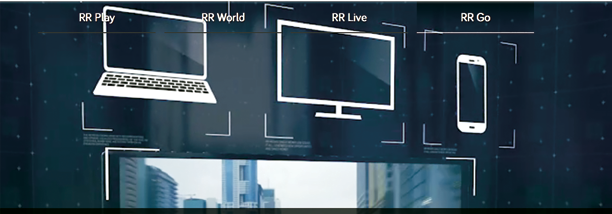In the age of increasing online content accessed from multiple devices, satellite distribution remains relevant. Satellite distribution networks still efficiently broadcast content to large audiences worldwide—however, TV isn’t limited to one box anymore.

Viewers now want to consume media from any device, at any time, and at any location. To meet these desires, providers need a system that offers multiple content delivery services to varied audiences at the same time.
Hybrid systems offer providers the flexibility to deliver content to different audiences in different regions, on multiple devices. Hybrid distribution systems that effectively combine broadcast and broadband capabilities in closely linked networks might provide a long-term solution for broadcasters.
What Is Hybrid Delivery?
Hybrid distribution combines broadcast and broadband networks. The approach delivers media content over satellite, fiber and the Internet. When combined, each method is complemented to create optimized, more connected content delivery mechanisms. Such brings benefits and new opportunities to content providers through providing the most enhanced viewing experiences to audiences.
Watching content becomes non-linear as viewers now are able to interact with content from multiple screens and devices and individualize their viewing with on-demand and other screening services.
The Rise Of Hybrid Delivery
As technology evolves, viewers expect a richer experience overall when consuming video content. Although older generations were once amazed by color TV, today’s consumers demand high-definition (HD) programming, and expect the picture quality to continue to improve. Viewers also expect clearer and more immersive audio as improved technology has improved the sound quality, as well.
In the same way, the widespread adoption and use of tablets, smartphones, and other devices has created the expectation to access interactive content on-demand from any device. With more advancements, consumers will only expect more and more from providers and the content they deliver.
Why Is Hybrid Delivery Needed?
Viewing habits are changing rapidly. Viewers are increasingly consuming content on-the-go from a variety of devices. According to data from January 2014, collected by Pew Research Center, 90 percent of American adults own a cell phone, 42 percent own a tablet, and 32 percent own an e-reader.
Viewers are using these devices to watch video content from anywhere. In a survey of 30,000 people in 60 countries conducted by Nielsen in August and September of 2014, 59 percent of respondents felt that watching video content from their phones is convenient, while 53 percent said a tablet is just as good as a laptop or personal computer. The report also found that viewers prefer to watch content from different devices, depending on where they are and what type of content they’re viewing.
What’s more, multiple devices allow viewers to watch content from different devices at the same time. More than 58 percent of respondents browse the Internet while watching video programming. The vast amount of content available, and the variety of devices to consume it from, it’s getting harder to keep viewers’ attentions.
Delivering relevant content to the right audiences is a major challenge broadcasters must now overcome in the face of so many viewing options. Hybrid distribution can help providers reach and engage viewers despite this barrier by optimizing content for a variety of regions, devices and consumptions options.
Here are some of the top benefits of using a hybrid delivery system:
Optimize content delivery
Using hybrid distribution allows providers to reach diverse audiences who access content on multiple platforms. Broadcast satellite, fiber and the Internet are optimized for the delivery of content on linear channels to large audiences, whereas Internet networks are best suited for interactive content, on-demand services, and niche media services.
Optimizing content can also address the problem of “second screens,” or losing viewers’ attentions to other devices. Innovative apps allow consumers to browse through content from their tablets and smartphones and watch it from their televisions. Then, viewers can interact with the content from their mobile devices. Other solutions allow viewers
to switch seamlessly from TV to mobile device while
viewing content.

It’s all about engaging with your viewers to provide the types of content they want to watch, when and how they want to watch it. Getting viewers involved in what they are watching by personalizing their content offering, will have enormous benefits in the long run: ability to better target advertising to specific viewers; new content monetization opportunities like subscriptions & pay-per-view; as well as accumulating business data through measurement tools, you can understand viewing preferences and tailor an engaging offering with rich potential.
Reach more viewers
Hybrid distribution also allows content providers to take existing content to new audiences. As the need to push out more and more content grows, satellite networks will allow companies to distribute a higher volume of content to a large audience. Providers can then repurpose the existing digital content for online delivery and consumption.
With content repurposed for different screens, content owners also need to think on a global scale with the ability to deliver locally. In order to attract new viewers and drive revenues, it’s vital to change standard content into local programming that can watched by audiences in their own language. By providing services like screen size conversions, subtitling, dubbing, tailored local advertising and more, media companies can localized content to further attract new audiences worldwide.
Hybrid distribution of content through multiple networks to various regions can broaden the customer base and create new business opportunities for providers.
Reduce costs
Hybrid solutions for satellite, fiber and online video distribution also help to reduce content operation and delivery costs. Delivering content to more places on more devices using a converged, single media workflow reduces the content handling and distribution costs.

RR Media’s complete ecosystem of digital media services maximize the potential of media and entertainment content, with a smart global content distribution network that optimizes content delivery over satellite, fiber and the Internet.
Elad Manishviz has served as CMO of RR Media since January 2014. He has over 15 years of experience and business leadership in the digital media, video, entertainment and advertising industries.
Prior to joining RR Media, Mr. Manishviz served in a broad range of executive positions in global communications, media-related software and Internet companies. He previously served as CEO of Wallstream, VP Products and Strategy at DG-MediaMind and as a VP of Products at NDS (acquired by Cisco).
Mr. Manishviz has an Executive MBA from the Hebrew University and a Bachelor’s degree in Media and Management from the Tel Aviv College of Management.


